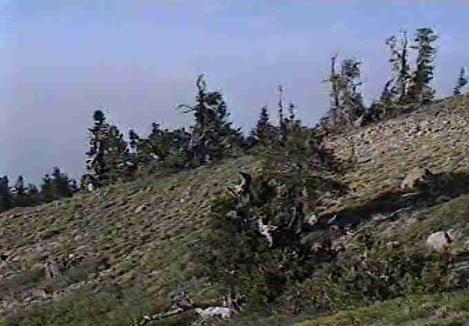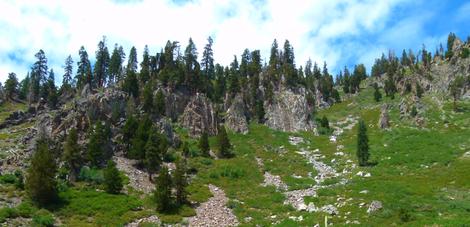see also Habitats
California high elevation forest, the Sub-Alpine Forest
Annual Precipitation:
30-50 in
Common Animals:
Chipmunks (these guys really get around), Mountain Sheep, Wolverine, Mountain Bluebirds, Clark's Nutcracker
Common Plants
Rock Spiraea (Petrophytum caespitosum), Roundleaf Snowberry (Symphoricarpos rotundifolius), Antelope Bitterbrush (Purshia tridentata), Foxtail Pine (Pinus balfouriana), Limber Pine (Pinus flexilis), Whitebark Pine (Pinus albicaulis), Sierra Columbine (Aquilegia pubescens), Sierra Penstemon (Penstemon heterodoxus), and Sierra Currant (Ribes cereum).
Soil and climate notes:
This plant community, the Subalpine Forest, would love to be a forest, but can freeze at any time, and have 100 mile/hour winds at any time. Camp on the hillside in a lightning storm and experience down strikes all around you, hundreds in an afternoon. All the trees look beat up from the tops being struck by lightning, ground being frozen for months and their tops being blown off. The cool summer temperatures mean the growing season is very short. Maybe July, August, and on a good year, September. A beautiful, stunning place in August, as long as there are no thunderstorms in the forecast.
Plants from this area need a little afternoon shade, cool, fast draining soil, no fertilizer or soil amendments. Soils can commonly be raw granite or scree. A spritz of summer water and a summer cool -down spray is also required in many areas. Growing plants from this community in soils with a pH of 7.5 or higher is REAL hard. Plants from this community feel right at home in the Northeast. People from Vermont or Maine should feel right at home in the few California towns that exist near this Subalpine Forests plant community.
Plants
A list of California native plants that grow in the Sub-Alpine Forest plant community.






